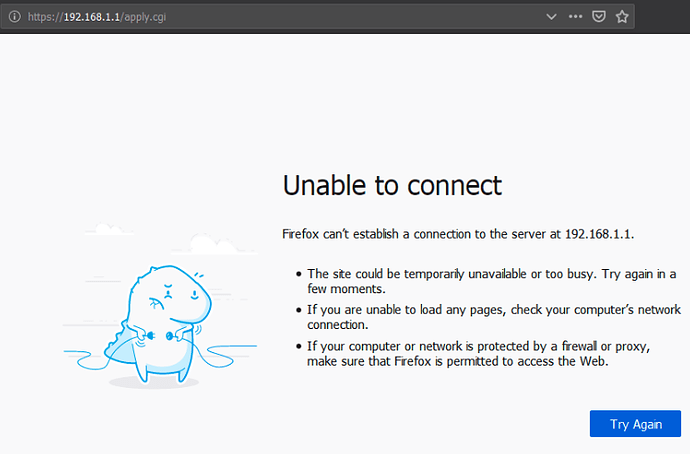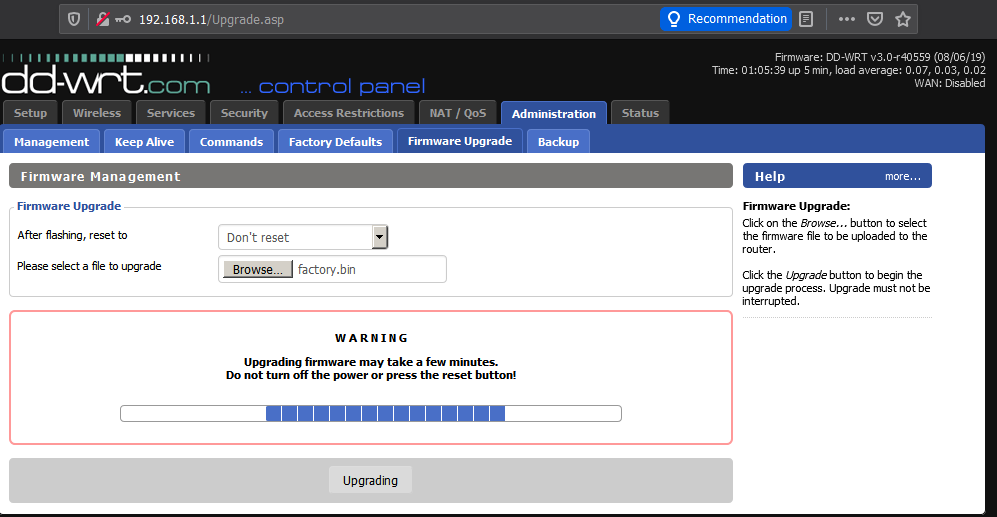Here's what happened.
I connected the router and the PC through a network cable, flashed the file "factory-to-ddwrt.bin" through the then openwrt web interface (I previously successfully flashed the corresponding image from OpenWrt Project).
Since then I can't access the user interface but can connect to the router's SSID which is named "dd-wrt".
Please help me ultimately access the web interface so that I can flash OpenWrt again.
OpenWrt is not DD-WRT
Which do you have flashed?
Edit: Unless you “forced”, OpenWrt sysupgrade for current versions generally wont flash a non-matching image. I would be surprised if it blindly flashed a DD-WRT image.
It sounds like you’re following directions for DD-WRT
I know OpenWrt is not DD-WRT.
First I flashed OpenWrt and everything was fine.
Later, I flashed DD-WRT and since then I'm having problems.
I just want to get back OpenWrt but I can't access the web interface.
Now I'm not sure if I flashed "factory-to-ddwrt.bin" or "tl-mr3420v1-webflash.bin". I downloaded both files from the DD-WRT website.
Well if there is WiFi then it looks like it's not bricked. Try to connect a LAN cable to the router LAN ports and then see what IP you get. Figure out the gateway of the router and access the web interface from there.
I would try, probably in this order:
- DD-WRT documentation and rescources, such as their forum (I'd try wired first over wireless)
- Trying to connect over wired as if it were your old OpenWrt install (long shot)
- Trying to connect over wired as if fresh OpenWrt install (ssh to 192.168.1.1) (even longer shot)
- TFTP recovery -- See https://openwrt.org/toh/tp-link/tl-mr3420#flash_via_tftp
Sorry, I didn't provide enough details.
Every time I make changes to the router I do it through the wire, not wireless.
The routers default gateway is 192.168.1.1 at this very moment. It was the same before but I can't access the web interface through it anyway.
Could you please give me more detailed instructions on how to do TFTP recovery on this router (TP-Link TL-MR3420 v1.2)
It seems that my only option is to flash the image through TFTP server using a serial line. What is a serial line?
My router only has ethernet ports and a usb port.
It seems that this is the only text that applies to my specific router:
Flash via tftp
Using a serial line
Download the factory update firmware: openwrt-ar71xx-generic-tl-mr3420-v1-squashfs-factory.bin
Connect your pc via serial interface.
Set up tftp server.
Name the firmware to code.bin and move to tftp folder.
Set the static IP address of the computer to: 192.168.1.27 (for MR3420/MR3220 versions v1.x) or 192.168.1.100 (for MR3420/MR3220 versions v2.x)
Power on the router, and type tpl if “Autoboot in ..” occurs (type fast!)
If it works you now should see something similar: ar7100>
Now you should type the following:
ar7100> erase 0x9f020000 +0x3c0000
ar7100> tftpboot 0x81000000 code.bin
ar7100> cp.b 0x81000000 0x9f020000 0x3c0000
ar7100> bootm 0x9f020000
I also don't know where to type the commands into.
And I'm not sure what to put in the Internet Protocol Verson 4 (TCP/IPv4) Properties: IP address, Subnet mask, Default gateway.
That is how you make your IP static, right?
I suppose like this?
IP address: 192.168.1.27
Subnet mask: 255.255.255.0
Default gateway: 192.168.1.1
And should I leave the DNS servers empty?
Could you please provide me with more detailed instructions. I would really appreciate it.
Since both OS use the same IP but a different web interface system, it could simply be that your PC's web browser is confused after the switch. Try clearing the browser cache.
Thanks, that lead me to this:
So it seems that every time I want to get to the web interface I have to clear the cache and factory reset the router.
When I do that and enter 192.168.1.1, the page loads but the "buttons" (Setup, Wireless, Services, Security, Access Restrictions, NAT / QoS, Administration, Status) are unclickable. When I put the mouse cursor over them, the cursor behaves as if I am going to select the text instead of click on the button/link. I click anyway and nothing happens.
I am able to type in the fields for "Router Username", "Router Password" and "Re-enter to confirm" but when I click on "Change Password" the page fails to load and the URL turns from "192.168.1.1" to "https://192.168.1.1/apply.cgi"
This is really not the place to debug or support dd-wrt, please head over to their forum regarding problems with that.
I'm not trying to debug nor support dd-wrt. I'm trying get back OpenWrt but can't access the web interface in order to flash OpenWrt to the router.
Whatever your end goal, your immediate questions are around DD-WRT. The expertise to resolve those are not here, but with DD-WRT.
Install OpenWrt with TFTP, assuming your router supports it.
Unless you set a password in DD-WRT, you won't be able to access the UI options. Try a different browser and then try to set up a password. Hopefully you can then flash OpenWrt.
Have you tried http://192.168.1.1/cgi-bin/luci/ ?
Your comments influenced me to discover that I had set the security settings in my browser to too high. Thank you. I changed them to standard, set a new password in DD-WRT to be able to get access to UI options as @ahmar16 said, and now I can get access to the web interface but still can't flash OpenWrt to the router.
@lleachii When I tried http://192.168.1.1/cgi-bin/luci/ the interface was minimalistic and that is when I found out that security settings were interfering with the functioning of the page.
When I choose a file to upgrade and click on "Upgrade" it starts and continues to "upgrade" into infinity. Well, untill I stop it. But I always wait at least 5 minutes.
I tried upgrading with:
"lede-17.01.5-ar71xx-generic-tl-mr3420-v1-squashfs-factory.bin",
"lede-17.01.5-ar71xx-generic-tl-mr3420-v1-squashfs-sysupgrade.bin"
and the stock firmware.
And it seems that some of the settings, like the firmware upgrade, just won't apply.
I tried it on both Chrome and Firefox.
You should be flashing OEM, then OpenWrt.
All Wiki directions assume you're flashing from OEM.
Follow ddwrt instructions to flash back to TP-Link stock, then flash OpenWrt.
As long as you're running ddwrt you should look to them for support.
Realize this model is not a good candidate for OpenWrt due to small memory size.
Ok guys, thank you all for your time and help. 
This topic was automatically closed 10 days after the last reply. New replies are no longer allowed.


